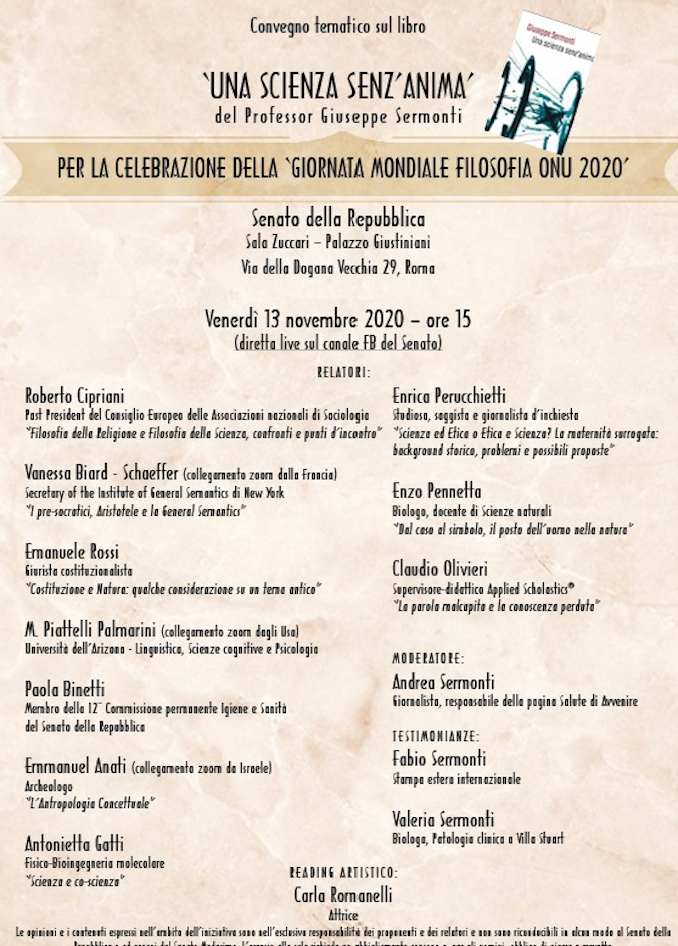
By Vanessa Biard-Schaeffer, Secretary and Trustee of the Institute of General
Semantics, New-York, USA
November 13th, 2020
If we were giving a lecture today on General Semantics we could have called it “Science and Sanity”.
Alfred Korzybski, the founder of General Semantics, aimed for sanity through the scientific method applied to everyday life.
By scientific methods we mean here mathematics. And by mathematics, we mean the ability to make explicit the silent presuppositions that we make almost all the time in your daily lives. In the field of philosophy of sciences it’s called epistemology. In the field of daily life, it’s called Sanity.
From the fragmentary writings of the pre-Socratics we can remember Parmenides’ “To be is, or is not”. In Parmenides, Being is an indivisible whole. In Heraclitus, on the contrary, change is the only permanence. You don’t cross the same river twice.
For Aristotle, there is a permanent substance and attributes that change. Medieval scholars looked at Aristotle, splitting hair in four and fingernails in eight, to distinguish the successive layers of logic, grammar, rhetoric, etc. and try to reach the Truth -with a capital T- above human contingencies.
Thanks to one or two geniuses, the study of language gave birth to the study of logic, and the study of logic itself gave birth to mathematics. Mathematics ended up freeing itself almost completely from Aristotelian logic. But our languages (French, Italian, English,
etc.) have remained imbued with an Aristotelian logic.
Our linguistic habits and thus, our representations of reality are Aristotelian, that is to say binary: True or False, Being or Not Being, etc. This Aristotelian logic is that of the excluded third party. Either a thing is, or it is not. A thing cannot be both A and Non-A in an Aristotelian system.
Mathematical languages and their equivalents in physics have given rise to other higher logics more suited to the description of reality. So we have every interest in understanding the limits of the logic we use when we speak.
Thus, Aristotelian logic in the whole of modern mathematics is a restricted logic, a special case in a larger whole. To make a comparison to illustrate this point, Aristotle’s logic is like a 2-dimensional geometry in a 3-dimensional world. 3-dimensional
geometry treats 2-dimensional geometry as a special case. We can speak in 2 dimensions in a 3-dimensional world, but the reverse is not possible. The line is the profile edge of a circle. The circle is the 2-dimensional representation of a sphere which itself is in 3 dimensions, etc.
It is very difficult to break away from Aristotelian logic if we do not put an end to certain linguistic habits. Other habits are impossible to remove under penalty of not being able to express yourself in a language, so new habits must be acquired to counterbalance the psycholinguistic reflexes acquired from childhood.
If the map that represents the territory is wrong, it is very likely that we get lost. Mental health is the ability to adapt one’s representation of reality according to the territory, and not to adapt the territory to the representations that one makes of it. This is the map that follows the territory, not the other way around (I suggest you try to drive off the road).
General Semantics makes it possible to understand that if my assumptions or premises are false, the reasoning, which follows, is false. The important thing here is to remember that my knowledge is made of assumptions and that if I have the courage to analyze
them, not to jump to conclusions like a monkey on a banana, I am a Man and behave as such, with well-integrated brains.
In the current situation, General Semantics allows you to develop your sense of observation in a sharp way, non-verbal, verbal, etc., to gradually develop an opinion that I know is necessarily based on assumptions and predicates. This is the theory and practice of uncertainty. Unfortunately, I don’t have time to detail the principles and method we use in General Semantics.
Today, as Baudrillard or Debord described it in their time, the simulacrum (the virtual) has taken more and more place over reality. Korzsybski aimed at sanity: that our maps adapt to real territory, not the other way around. Structuralism reversed this meaning
by asserting that changing our representations of reality could create a new territory. And by pushing this reversed logic to its ultimate logic, we arrive at the current situation: the virtual discourse is more important than the observed facts.
Much of our financial and political elites, tired of managing the people, have become like those teenagers locked in their online computer games that reject the outside world. They have taken refuge in the dummy. But instead of them being locked in their rooms,
they want us to be locked away forever. They hate organic life because they can’t control it. Very immature, their world is small.
According to Heraclitus, life is a constant struggle. And if the Pope has given up his title of Vicar (representative) of Christ in April 2020, the mothers of whom I am will be helped by the Blessed Virgin in our fight against obscurantist forces. The Christian Trinity reports on this fight where Strength, Intelligence and Love must be united for the ultimate fight against technocracy. The virtual (the map) does not command Life. Thank you for your attention.
Vanessa Biard-Schaeffer
Solari Reports:
